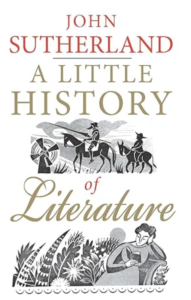Autumn reading and literary history
A Little History of Literature for Young Readers at Yale University is a book written by the British author and literary scholar John Sutherland, whose book is available as a free download from the Yale University website,

It will be an accessible introduction to the history of literature, its major authors and works, aimed at young readers and beginners in literature.
The book will be characterised by a familiar narrative style rather than complex academic language to explain the history of literature, a concise account of literature from ancient times to the present day, and an introduction to representative writers and works from each period, explaining how literature has developed and influenced society and culture.
Literature is an art form that expresses human experiences, feelings and ideas through words, and includes works written in a variety of forms, such as poetry, novels, plays and essays.
Sutherland states that literature is the highest human knowledge that expresses and interprets the world around us, and that the best literature never simplifies a story, but broadens our minds and sensibilities to accept the complexity of the world. He also states that reading literature makes us more human and that the more skillfully we read, the more we benefit.
In this issue, I would like to discuss some topics picked up from this book.
Chapter 2: A beautiful beginning – myths
Chapter 2 of the book discusses mythology as the beginning of literature. Myths are stories told by ancient peoples to explain natural phenomena, the origins of the world and the origins of human beings, etc. In Japan, there is the Kojiki, as described in ‘Kaido yuku – Katsuragi Michi’ etc. In the West, Greek myths in which Zeus and Hercules appear, as well as the Norse myths in which Odin and Thor appear, In the West, there are Greek myths in which Zeus and Hercules appear, Norse myths in which Odin and Thor appear, and Egyptian myths in which Osiris and Ra appear in Asia.
Sutherland explains that these myths are created because ‘we form our mental shapes and patterns instinctively from the variety of things around us — babies are born into a giddy chaos in which everything seems to bloom at once. Humans have to make peace with such terrifying chaos, and myths help us to understand the world. — The essential function of myths is to create patterns that don’t really exist because finding a pattern makes things easier to understand (and easier to remember) — Myths (stories) add meaning to a life that feels meaningless.’ He states such things as.
This is illustrated in ‘Life as Information – Purpose and Meaning’, which states that ‘For the organism to function effectively as an organised and complex system, it needs to continuously collect and use information about the state of both the outer world in which it lives and the inner world of the body. The inner and outer worlds change, and living organisms need ways to detect and react to these changes. Otherwise, they would not be able to live very long’, which can be considered to amount to an organism’s dependence on the information it needs to survive and the act of creating patterns of information and assigning meaning to them in order to use them to achieve a particular purpose.
Chapter40 Literature and your life – and beyond
The final chapter of the book discusses what literature will look like in the future, after more than 500 years of printed books made of paper and ink, which have evolved considerably in recent years to become e-books.
In response to this question, Sutherland states that in the future, more literature will be read in different ways (audio, visual, virtual, etc.) and that very personal literature, such as fanfiction, will be consumed with the benefit of the internet.
He states that the last one, in particular, does not have a fixed final form, but changes its shape like water according to the environment of the moment, producing something that is neither a product nor a professional work produced by a large number of conversations. Sutherland also states that language is by nature changeable, and that this trend is a move to revive the fluidity that literature had in the first place, and that this will be a major change to restore a sense of unity between the creator and the reader.
The book ends with the hope that the danger of the reader being crushed by the mass of information and unable to convert it into knowledge will be overcome by the wonderful imagination of the human spirit, and that the communion of thought through literature will become stronger, more dense and more active.
Spending an autumn evening nurturing the imagination by reading a book may be one of the most rewarding pages of your life.


コメント